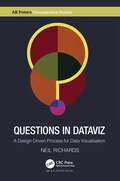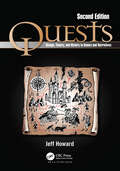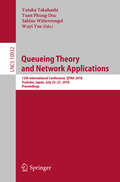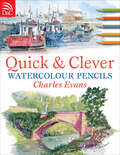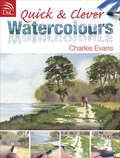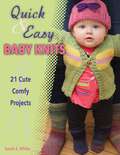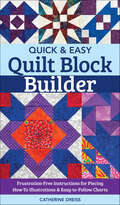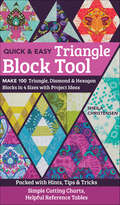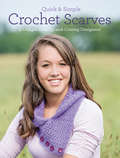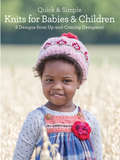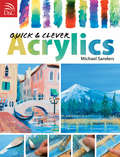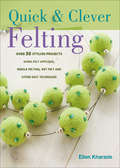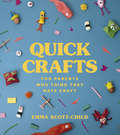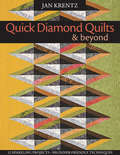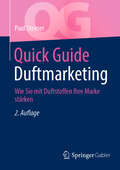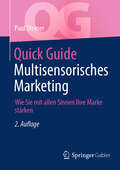- Table View
- List View
Questions in Dataviz: A Design-Driven Process for Data Visualisation (AK Peters Visualization Series)
by Neil RichardsThis book takes the reader through the process of learning and creating data visualisation, following a unique journey with questions every step of the way, ultimately discussing how and when to bend and break the "rules" to come up with creative, unique, and sometimes unconventional ideas. Each easy-to-follow chapter poses one key question and provides a selection of discussion points and relevant data visualisation examples throughout. Structured in three parts: Section I poses questions around some fundamental data visualisation principles, while Section II introduces more advanced questions, challenging perceived best practices and suggesting when rules are open to interpretation or there to be broken. The questions in Section III introduce further themes leading on to specific ideas and visualisation projects in more detail. Questions in Dataviz: A Design-Driven Process for Data Visualisation will appeal to any reader with an interest in creative or unconventional data visualisation and will be especially useful for those at a beginner or intermediate level looking for inspiration and alternative ways to deploy their data visualisation skills outside of conventional business charts.
Quests: Design, Theory, and History in Games and Narratives
by Jeff HowardCombining theory and practice, this updated new edition provides a complete overview of how to create deep and meaningful quests for games. It uses the Unity game engine in conjunction with Fungus and other free plugins to provide an accessible entry into quest design. The book begins with an introduction to the theory and history of quests in games, before covering four theoretical components of quests: their spaces, objects, actors, and challenges. Each chapter also includes a practical section, with accompanying exercises and suggestions for the use of specific technologies for four crucial aspects of quest design: • level design • quest item creation • NPC and dialogue construction • scripting This book will be of great interest to all game designers looking to create new, innovative quests in their games. It will also appeal to new media researchers, as well as humanities scholars in the fields of mythology and depth-psychology that want to bring computer-assisted instruction into their classroom in an innovative way. The companion website includes lecture and workshop slides, and can be accessed at: www.designingquests.com
Queueing Theory and Network Applications: 13th International Conference, QTNA 2018, Tsukuba, Japan, July 25-27, 2018, Proceedings (Lecture Notes in Computer Science #10932)
by Yutaka Takahashi Wuyi Yue Sabine Wittevrongel Tuan Phung-DucThis book constitutes the proceedings of the 13th International Conference on Queueing Theory and Network Applications, QTNA 2018, held in Tsukuba, Japan in July 2018.The 8 full papers together with 10 short papers included in this volume were carefully reviewed and selected from 57 initial submissions. All the papers to be presented disseminate the latest results covering up-to-date research fields such as performance modeling and analysis of telecommunication systems, retrial and vacation queueing models, optimization of queueing systems, modeling of social systems, application of machine learning in queueing models.
Quick & Clever Handmade Cards: Over 80 Projects and Ideas for All Occasions
by Julie HickeyWeddings, Birthdays, Christmas, Get Well, Good Luck and more: the variety of occasions on which a handmade card would be appreciated is endless! This book offers such a huge variety of fast and easy-to-complete design ideas that you will be spoilt for choice when deciding what to make. Ideas for making matching envelopes, inserts and even batches of cards are included. In addition, there are lots of tools and embellishments to choose from to make your card really special: beads, punches, rubber stamps, charms, ribbons and lots more. 16 step-by-step projects each show you how to make a different card, complete with advice and tips for maximum speed and ease. Each project has two illustrated variation ideas, while eight pages of galleries offer yet more design inspiration and help.
Quick & Clever Watercolour Pencils: Step-by-step Projects For Spectacular Results (Quick And Clever Ser.)
by Charles EvansThe British artist and TV personality shows you how to get the very best results from watercolour pencils wherever and whenever you choose to create. Watercolour pencils are versatile, fun and easy-to-use no matter where you are. In Quick & Clever Watercolour Pencils, Charles leads you through the entire process of learning how to use these invaluable tools effectively, revealing his ingenious tips and tricks along the way. Packed with information on tools, materials and techniques Varied projects for outdoors and indoors, ranging from simple landscapes to more complex compositions, and from pets to buildings Inspirational pages from Charles&’ own sketchbooks that clearly demonstrate the immediacy of this medium
Quick & Clever Watercolours: Step-by-step Projects For Spectacular Results (Quick And Clever Ser.)
by Charles EvansThe British artist and TV personality shows you how to have fun with watercolours by scribbling away, using big brushes, and slapping on paint. Accomplished artist, Charles Evans, will have you painting in no time with these cleverly-constructed art projects that can each be completed in a matter of minutes. Packed with simple techniques and top tips that will ensure successful results every time, Charles&’ easy-to-follow instruction will help improve your painting skills at once. Quick & Clever Watercolours . . . Helps you learn professional hints and tricks about using watercolours and watercolour pencils which offer extra flexibility and convenience Includes varied art projects for outdoors and indoors, ranging from simple landscapes to more complex compositions, from pets to still lives Reveals inspirational pages from Charles&’ own sketchbooks that clearly demonstrate the immediacy of this medium
Quick & Easy All Stars Block Tool: 110 Quilt Blocks in 5 Sizes with Project Ideas
by Debbie RodgersIncludes more than 100 dazzling star blocks in the tried-and-true block tool format! The All Stars Block Tool makes all-star quilts! This collection of 110 blocks in the no-math reference format features a variety of traditional and innovative star designs. Each block has detailed reference tables, cutting instructions, exploded construction diagrams, project inspiration, and color examples. It includes 20 popular star blocks from the block tool series while introducing 90 brand-new star blocks. From variations on classic sawtooth and bear paws to innovative, fresh star designs using a triangle in a square, this block tool will surely delight your starry dreams! Each of the 110 star quilt blocks includes cutting and yardage reference tables for five sizes, value layouts, project illustrations, and color inspiration The user-friendly cutting instructions, block indexes, precut-friendly projects, and line drawings make planning quilts a breeze! Use the exploded construction diagrams to piece every block with ease
Quick & Easy Baby Knits
by Sarah E. White21 projects for blankets, socks, hats, tops, bottoms, and accessories for newborns to 1 year olds.
Quick & Easy Quilt Block Builder
by Catherine DreissTraditional quilt blocks are made up of common elements such as Flying Geese, Square-in-Squares, and Quarter-Square Triangles. Each of the elements can be constructed in a variety of ways—choose the ones that are easiest and most efficient! In this one book, you will find each method carefully broken down, explained, and illustrated, along with comprehensive sizing information. It’s the ultimate no-math, no-stress reference for all common quilt block elements! Keep cutting instructions and size charts right on your cutting table with this handy, lie-flat reference Don’t waste time figuring out quilt block element sizes! We’ve done the math for you An indispensable guide to combining classic quilt block elements Bonus: downloadable paper-piecing templates and blocks to try!
Quick & Easy Triangle Block Tool: Make 100 Triangle, Diamond & Hexagon Blocks in 4 Sizes with Project Ideas
by Sheila ChristensenEverything you love about the Quick & Easy Block Tool, now with triangle blocks! This ultimate no-math reference guide for quilters includes cutting charts, piecing tips, quilt layout ideas, and a visual index of blocks. Plus, get basic cutting instructions using straight or 60° triangle rulers for triangles, diamonds, jewels, half diamonds, parallelograms, hexagons, half hexagons, lozenges, and half lozenges. Ultra-portable and indispensable, this is the block guide that no quilter, modern or traditional, should be without! Easy-to-use format in a take-along size Packed with handy reference tables, helpful charts, design tips, diagrams, color inspiration, and more Keep cutting instructions at your fingertips
Quick & Simple Crochet Hats: 8 Designs from Up-and-Coming Designers! (Quick & Simple)
by Melissa Armstrong Ava Lynne GreenLearn to stitch your own caps, cloches and more with Quick and Simple Crochet Hats! Look inside to find: 8 unique patterns from independent crochet designers. Simple technique guides for creating eye-catching stitches. Beautifully wearable projects perfect for any skill level!
Quick & Simple Crochet Scarves: 9 Designs from Up-and-Coming Designers! (Quick & Simple)
by Melissa Armstrong Anastasia PopovaLearn to stitch your own wraps, cowls and shawls with Quick and Simple Crochet Scarves! Look inside to find: 9 unique patterns from independent designers. Simple technique guides for creating eye-catching stitches. Beautifully wearable projects perfect for any skill level.
Quick & Simple Crochet for the Home: 10 Designs from Up-and-Coming Designers! (Quick & Simple)
by Tanis Galik Melissa ArmstrongLearn to stitch everyday items for your kitchen, bedroom and more with Quick and Simple Crochet for the Home! Look inside to find: 10 unique patterns from independent crochet designers. Simple technique guides for creating eye-catching stitches. Beautiful and durable projects perfect for any skill level.
Quick & Simple Knit Hats & Scarves: 8 Designs from Up-and-Coming Designers! (Quick & Simple)
by Kendra Nitta Rosalyn JungLearn to stitch caps, wraps and more with Quick and Simple Knit Hats and Scarves! Look inside to find: 14 unique patterns from independent knitting designers. Simple technique guides for creating eye-catching stitches and designs. Beautiful and durable projects perfect for any skill level.
Quick & Simple Knits for Babies and Children: 8 Designs from Up-and-Coming Designers! (Quick & Simple)
by Kendra Nitta Rosalyn JungLearn to stitch adorable clothes for infants, toddlers and kids with Quick and Simple Knits for Babies and Children! Look inside to find: 8 unique patterns from independent knitting designers. Simple technique guides for creating eye-catching stitches and designs. Beautiful and durable projects perfect for any skill level.
Quick And Clever Acrylics
by Mike SandersQuick & Clever Acrylics offers a comprehensive introduction to painting with acrylics the 'quick & clever' way, ideal for newcomers to the medium. It explores the full potential of acrylics (using them as watercolors and oils) focusing on getting top results quickly. Each project explores painting a popular subject, starting with technique focused exercises and moving onto a step-by-step painting .It makes getting to grips with acrylics easy, fast and fun!
Quick And Clever Felting
by Ellen KharadeDiscover felting the quick and clever way with over 30 fun and fabulous projectsEssential easy-to-follow techniques include needle felting, wet felting, fulling and using ready made feltVariation ideas show just how easy it is to adapt the designs to suit your own styleColorful designs range from beautiful jewelry, bags and cushions to quirky toys and slippersEach irresistible project can be completed in a day, but will make a lasting impression
Quick Crafts for Parents Who Think They Hate Craft
by Emma Scott-ChildIf the thought of getting crafty with your children fills you with glittery dread then this book is for you.Quick Crafts for Parents Who Think They Hate Craft is packed with 40 projects free from crazy origami to lose your cool over and PVA glue to clean out of everyone’s hair. Get creative with your children even if you’re short on time (or patience). Split into 4 sections: play with it, wear it, spruce it up and useful things, all of the crafts have been created to ensure that play can continue once the crafting is over. Go on a swashbuckling adventure complete with pirate hook and sword, whale watching in the bath or a leafy jungle safari with hairy baboons and rattling snakes.Crafting doesn’t have to leave you cranky and the floor sticky!
Quick Crochet for Kitchen and Home: 14 Patterns for Dishcloths, Baskets, Totes, & More
by Salena BacaAdd a pop of color and style to your home with these quick crochet pieces!Bringing new textures and colors into your home decor can make all the difference, and with these pieces you can make a whole selection of items for seasonal changes or just to suit your mood. Crochet colorful dishcloths, trivets, and potholders for the kitchen; a beautiful runner, plant hanger, and place mats for your dining room; and a basket, rug, and more for any room in your house. All of the patterns in this book work up in just a few hours, and are perfect for crocheting on the go. With just a hook and yarn in colors you love, you can brighten up every room in your house!
Quick Crochet for the Home: 20 Fast Projects to Liven Up Every Room
by Tamara KellyHook Up Your Home with Crochet Style! No crocheter's home decor is complete without a little yarny goodness. From the foyer to the kitchen and every room in between, Quick Crochet for the Home has easy and fresh patterns you'll love to stitch for all your living spaces. Popular crochet designer Tamara Kelly offers 20 projects that not only stitch up in a flash, but also feature the clean lines and contemporary colors of today's modern home. Make a statement in the living room with the Bold Diagonal Throw Pillow. Stitch up some serenity for the bathroom with the Spa Jar Covers. Add some whimsy to a child's bedroom with the Smart as a Fox Bookends. Wherever your home needs a little more crochet, inside this book you'll find the perfect project to suit your decor.
Quick Crocheted Accessories (3 Skeins or Less)
by Sharon ZientaraCrochet accessories are as easy as 1, 2, or 3 skeins of yarn! In Quick Crocheted Accessories, author Sharon Zientara has curated a collection of crocheted projects that make use of one, two, or three skeins of yarn, allowing for both color play and larger projects. Crocheters will enjoy quick crochet projects including scarves and shawls, hats, fingerless mitts and mittens, and slippers and socks! They'll discover single-skein projects that are simple and quick to crochet, budget-friendly, or offer a beautiful way to use a special skein of luxury yarn as well as crochet projects that take two or three skeins offering larger or more complex stitch patterns and colorwork. Featured designers include Kathy Merrick, Brenda K. B. Anderson, Beth Nielsen, Cristina Mershon, Terri Keller, Jessica Bolof, and Linda Skuja. Their designs include stitch patterns and motifs that are textural, reversible, and fresh.
Quick Diamond Quilts & Beyond: 12 Sparkling Projects - Beginner-Friendly Techniques
by Jan KrentzThe popular quilt designer and teacher demonstrates beginner-friendly techniques with these 12 new diamond quilt patterns without inset seams! Quilting with geometric patterns such as diamonds can seem challenging. But in Quick Diamond Quilts & Beyond, award-winning quilting instructor Jan Krentz shares her own classroom-tested techniques that make diamond quilting easy. Artists new to quilting will enjoy these lighthearted, original patterns featuring large shapes, easy piecing options, and fresh fabric combinations. Jan also offers tips on color value, texture, and contrast to enhance your fabric selection, and shows how using geometric fabrics can make your quilts shine.
Quick Guide Duftmarketing: Wie Sie mit Duftstoffen Ihre Marke stärken (Quick Guide)
by Paul SteinerDieses Buch ist eine kompakte Einführung in das Duftmarketing und bietet Marketingverantwortlichen, die ihrem Unternehmen bzw. ihren Marken ein unverwechselbares Duftprofil verleihen möchten, zahlreiche pragmatische Hilfestellungen für die Umsetzung. Es geht darum, mit Hilfe von Duftstoffen den Absatz von Produkten und Dienstleistungen positiv zu beeinflussen bzw. zu steigern, als auch das Markenimage und die Kundenbindung zu stärken. Paul Steiner liefert für die Unternehmenspraxis wichtige Ansatzpunkte zur olfaktorischen Gestaltung von Marken, die durch konkrete Beispiele – Singapore Airlines und MINI – illustriert werden. Drei Experteninterviews runden das Buch ab. Die 2. Auflage dieses Werks wurde überarbeitet und um wichtige aktuelle Blickwinkel erweitert. Der Inhalt Wahrnehmung und Wirkung olfaktorischer Reize Markenrecht – Die Duftmarke Duftmarketing Praxisbeispiele olfaktorischer Marken Ausblick Experteninterviews Zielgruppe Dozierende und Studierende aus den Bereichen Marketing, Kommunikation und Werbung Markenverantwortliche, Markenberater Der Autor Paul Steiner ist promovierter Sozial- und Wirtschaftswissenschafter. Neben seiner Promotion mit Auszeichnung zum Dr. rer.soc.oec. an der Wirtschaftsuniversität Wien, erhielt er den Rudolf Sallinger-Preis für seine Diplomarbeit „Sensory Branding&“. Dr. Steiner ist Autor zahlreicher Fachbücher u.a. „Quick Guide Visuelles Marketing&“ (2025), „Quick Guide Haptisches Marketing&“ (2025), „Quick Guide Multisensorisches Marketing<span lang="EN-US" style="font-size: 11.0pt; line-height: 107%; font-family: 'Aptos',sans-serif; mso-ascii-theme-font: minor-latin; mso-fareast-font-family: Aptos; mso-fareast-theme-font: minor-latin; mso-hansi-theme-font: minor-latin; mso-bidi-font-family: 'Times New Roman'; mso-bidi-theme-font: minor-bidi; mso-ansi-language: EN-U
Quick Guide Multisensorisches Marketing: Wie Sie mit allen Sinnen Ihre Marke stärken (Quick Guide)
by Paul SteinerDieses Buch ist eine kompakte Einführung in das Thema Multisensorisches Marketing. Paul Steiner untersucht die marketingspezifische Relevanz des menschlichen Sinnessystems und die verschiedenen Facetten (multisensualen) multisensorischen Brandings und bietet zahlreiche pragmatische Hilfestellungen für die Umsetzung. Für die Unternehmenspraxis werden wichtige Ansatzpunkte zur multisensorischen Gestaltung von Marken geliefert, um so Konsumenten langfristig und mit allen fünf Sinnen an eine Marke zu binden und damit Markeninhalte tiefgreifend zu verankern. Dies wird durch konkrete Beispiele von Singapore Airlines, Swarovski und MINI illustriert. Zwei Interviews mit renommierten Experten aus Wissenschaft und Praxis runden das Buch ab. Die zweite Auflage wurde aktualisiert und durch die Themen Multisensorisches Markendesign, Erlebnismarketing und Multisensorische Markenführung in der Automobilindustrie ergänzt.
Quick Guide Nachhaltigkeit in der Immobilienwirtschaft: Wie Sie die ESG-Kriterien in der Immobilienbranche richtig anwenden (Quick Guide)
by Christoph StraubeDieses Buch erklärt, was die ESG-Kriterien Umwelt, Soziales und Governance für die Immobilienbranche bedeuten und wie Unternehmen nachhaltiges Wirtschaften in der Praxis umsetzen können. Der Autor erläutert anschaulich die Auswirkungen in verschiedenen Bereichen, etwa in der Projektentwicklung, der Investitionsplanung, bei Maklern oder im Gebäudemanagement. Darüber hinaus wirft er einen fokussierten Blick auf digitale Lösungen bei der Umsetzung von ESG-Anforderungen und erläutert warum das Thema in Zukunft ganz oben auf die Agenda von Immobilienunternehmen rücken muss
